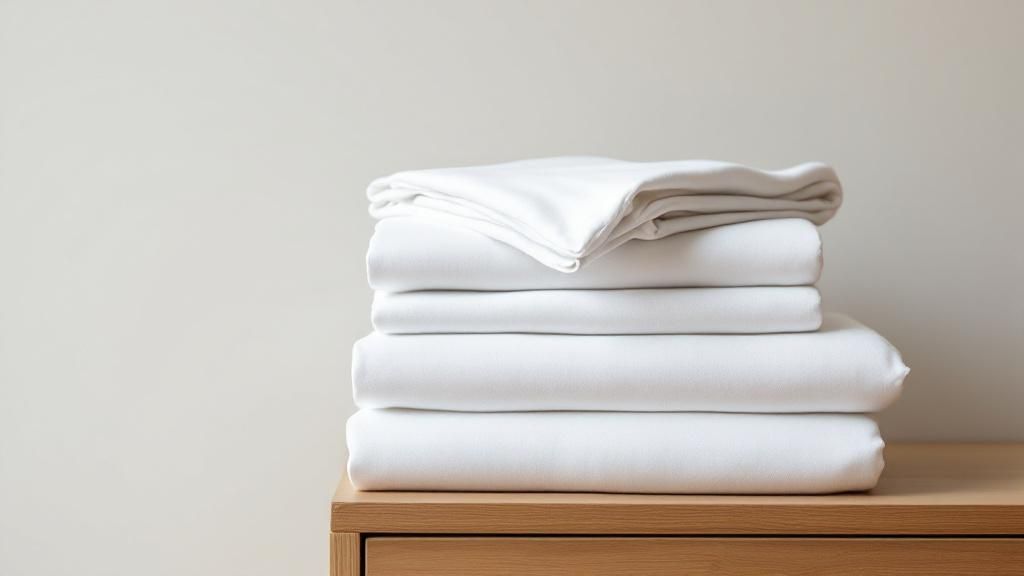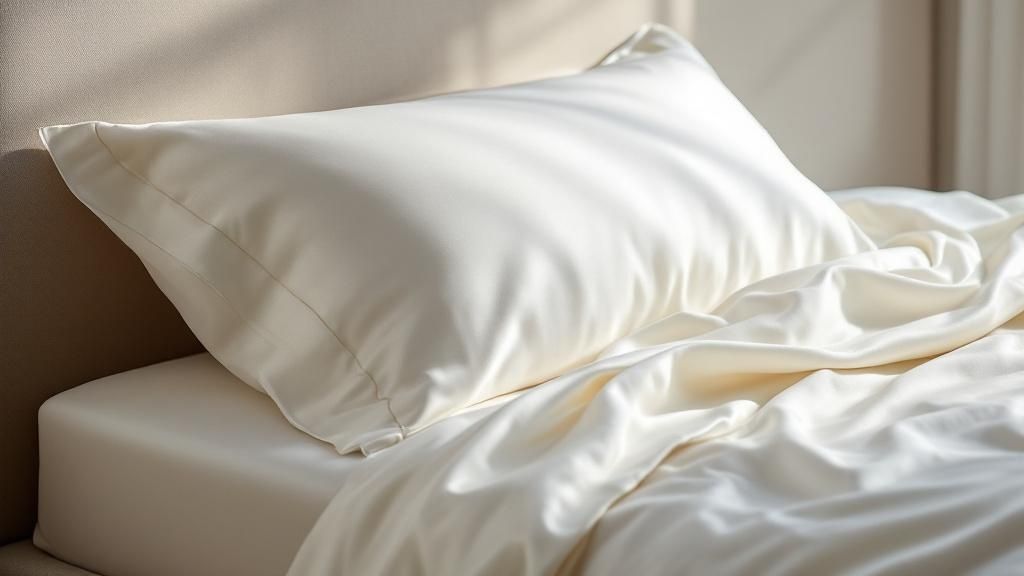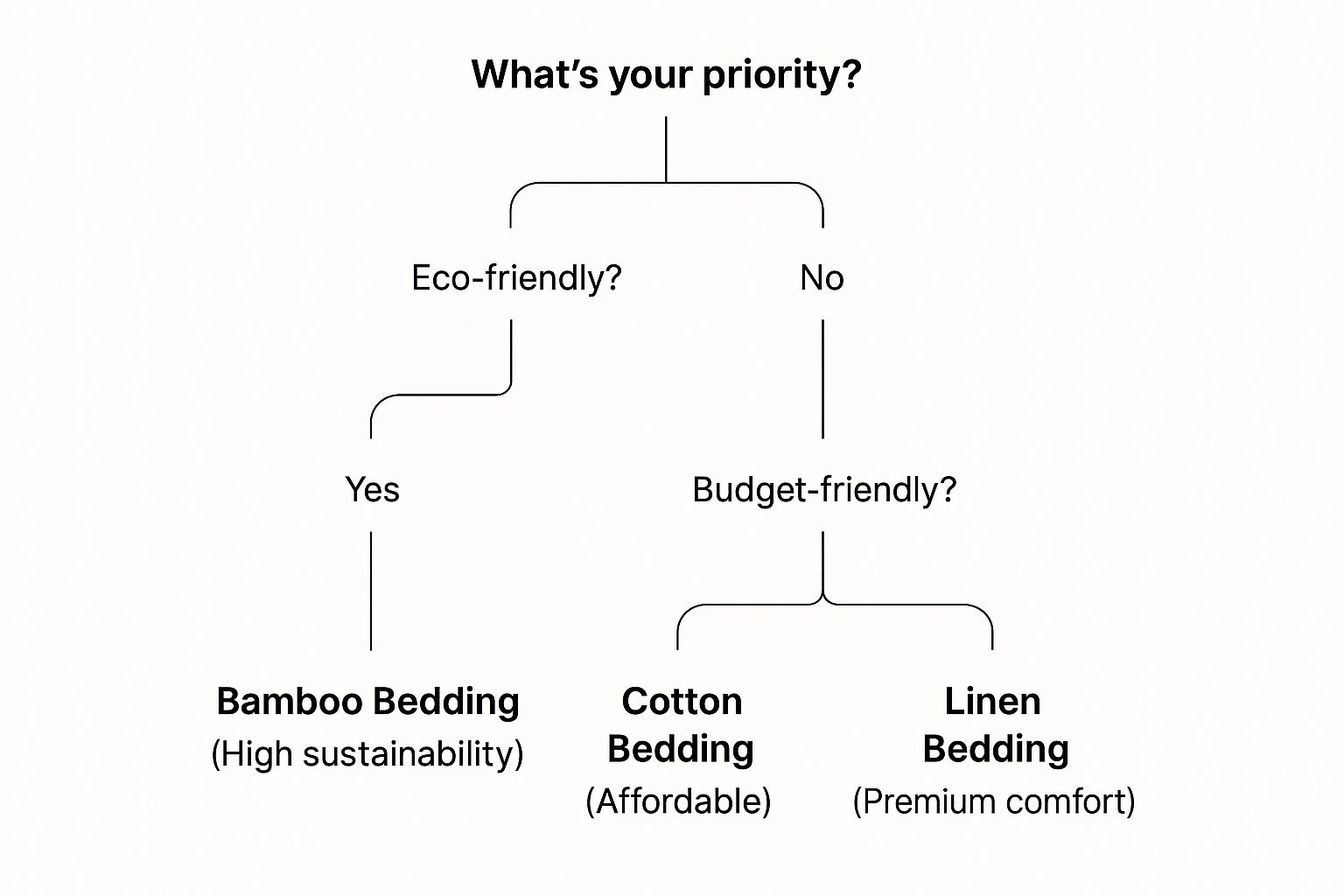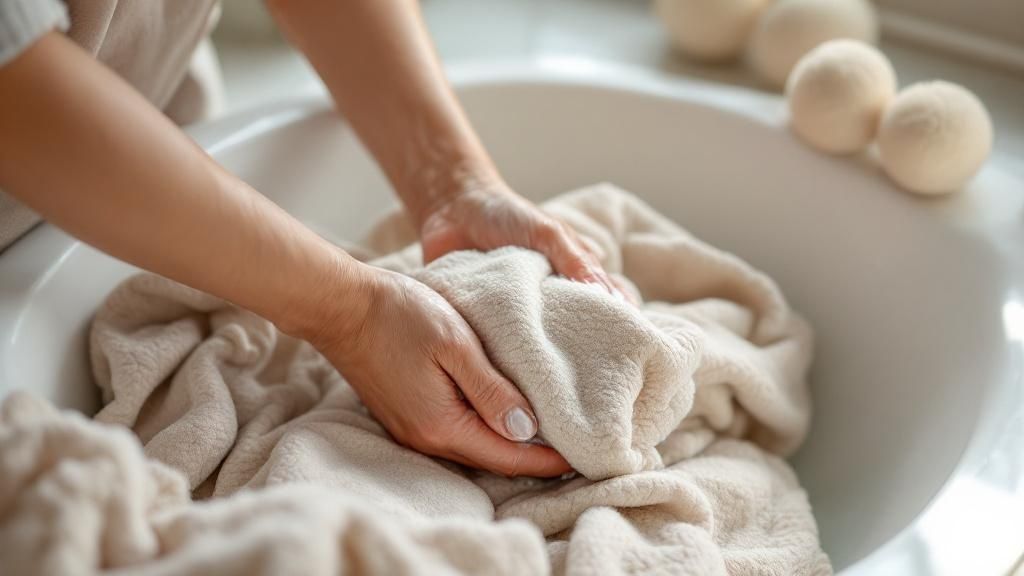While personal preference is always king when it comes to bedding, 100% organic bamboo often comes out on top. It’s a fantastic all-rounder, loved for its silky-soft feel, incredible breathability, and eco-friendly credentials. If you're looking for something that keeps you cool and is gentle on sensitive skin, bamboo is tough to beat.
Your Guide to a Better Night's Sleep
Choosing the right bedding goes way beyond picking a color or pattern. It’s about building a foundation for truly restorative sleep. The perfect fabric feels amazing against your skin, lets air flow freely, and helps keep your body at a comfortable temperature all night long. This guide will help you cut through the marketing fluff and focus on what really matters.
Ultimately, the "best" material is what works for you. Are you a hot sleeper? Do you have sensitive skin? Is sustainability a top priority for your purchases? Let's give you the knowledge to turn your bed from just a piece of furniture into a genuine sleep sanctuary.
Understanding Your Options
To find your perfect match, it helps to know the main players. Each one offers a completely different feel and sleep experience.
- Cotton: The timeless classic. You can get that crisp, cool hotel-sheet feel with percale or a silkier, smoother touch with a sateen weave.
- Linen: Famous for its unmatched breathability and airy feel, making it a dream for hot sleepers or warm climates.
- Bamboo: Praised for its luxurious softness, natural temperature-regulating abilities, and hypoallergenic properties.
This growing consumer focus on high-quality comfort and style is making waves. The global home bedding market was valued at an impressive USD 112.6 billion in 2024 and is expected to more than double, reaching USD 229.9 billion by 2034. It's clear people are investing more in their sleep quality.
Here's a quick comparison to help you narrow down the choices.
Quick Comparison of Popular Bedding Materials
Use this table as a starting point to see which bedding material aligns with your personal sleep preferences and priorities.
| Material | Best For | Feel | Key Benefit |
|---|---|---|---|
| Bamboo | Hot sleepers, sensitive skin, eco-conscious buyers | Silky, smooth, and soft | Superior temperature regulation and moisture-wicking |
| Cotton (Percale) | Those who love a crisp, cool feel | Light, crisp, and matte | Excellent breathability and a classic hotel-sheet feel |
| Cotton (Sateen) | Sleepers wanting a silky, luxurious touch | Smooth, slightly heavier, with a subtle sheen | Resists wrinkling and has a very soft, luxe hand-feel |
| Linen | Warm climates, people who want a casual look | Textured, airy, and gets softer with every wash | The most breathable natural fiber, incredibly durable |
No matter which fabric you lean towards, remember that your choice is a key part of your overall sleep environment.
Your bedding is more than just a decorative element; it is a key component of your sleep hygiene. The right material can significantly improve sleep quality by addressing issues like overheating and skin irritation.
Once you’ve got your fabrics sorted, adding a calming scent is a great next step. A light mist of something like the Aromatic Creation Sleep Well Linen Room Spray can help signal to your brain that it's time to wind down and create an even more serene atmosphere for sleep.
A Closer Look at Cotton and Linen

When you're searching for bedding made from trusted, natural fibers, two names always come to mind: cotton and linen. They're classics for a reason, offering the kind of comfort and durability that people have relied on for generations. But each one brings something unique to the bedroom. Let's dig a little deeper to figure out which might be the perfect fit for you.
Getting to Know Cotton
Cotton is a chameleon in the world of fabrics, but not all cotton sheets are the same. The real secret to its quality is something called staple length—basically, how long the individual fibers are.
- Upland Cotton: You'll find this everywhere. It's the most common and budget-friendly option, made with shorter fibers that result in a perfectly pleasant but less durable fabric.
- Pima Cotton: Grown mostly in the American Southwest, Pima is a step up. Its long-staple fibers create a noticeably softer and more resilient sheet.
- Egyptian Cotton: This is the gold standard. With extra-long-staple fibers, it produces an exceptionally soft, strong, and breathable fabric that stands up to pilling beautifully.
The global appetite for high-quality bedding is huge. The Asia-Pacific region, for instance, accounts for roughly 40% of worldwide revenue in the bedroom linen market. Over in Europe, the market is also seeing strong growth, largely because consumers are seeking out luxury and sustainable choices like Egyptian cotton.
It's All in the Weave
Beyond the fiber itself, the way cotton is woven completely changes how it feels against your skin. A percale weave, with its simple one-over-one-under pattern, results in a light, crisp fabric with a matte finish. If you love that classic, cool hotel sheet feel, percale is your friend, especially if you tend to sleep hot.
On the other hand, a sateen weave places more threads on the surface. This gives it a silkier, smoother hand-feel and a subtle sheen, making it a bit cozier and warmer. If you’re weighing your options, our guide on bamboo sheets vs cotton can offer even more insight.
The Laid-Back Luxury of Linen
Linen, which comes from the flax plant, is another giant in the natural fiber world. It's famous for its incredible breathability and moisture-wicking ability, making it a dream for anyone who sleeps hot or lives in a humid climate.
Linen is one of the strongest natural fibers you can find. What’s really special is that it gets softer and more comfortable with every single wash.
Part of linen's appeal is its relaxed, naturally rumpled look. Yes, it wrinkles, but that's what gives it so much character. To keep it in great shape, just wash it in cool or lukewarm water and tumble dry on a low setting. This protects the fibers and helps them soften over time, making it a comfortable investment that truly lasts.
Decoding Eco-Friendly Bamboo and Tencel
If you’re trying to make a more sustainable choice for your bedding, you've likely come across bamboo and Tencel. Both feel incredibly luxurious and soft to the touch, but the way they get from plant to fabric tells two very different environmental stories.
Bamboo fabric, which you'll often see sold as bamboo viscose or rayon, is famous for that signature silky feel and beautiful drape. It’s a dream for hot sleepers because the fibers are naturally moisture-wicking and breathable, helping you stay cool all night.
Those smooth fibers also make it a fantastic choice if you have sensitive skin, as it's naturally hypoallergenic. The material is made by breaking down bamboo pulp and spinning it into fibers, which is what gives it that softness so many people love. If you want to get into the nitty-gritty, you can learn more about what bamboo sheets are and what makes them such a popular option.
The Tencel Difference
Now let’s talk about Tencel. Tencel is actually a brand name for a specific type of fabric called lyocell, and it really raises the bar on sustainability. It’s produced from wood pulp, usually from eucalyptus trees grown in sustainably managed and certified forests.
The real magic of Tencel lies in its closed-loop production system. This is a big deal. It means that over 99% of the water and non-toxic solvents used to break down the wood pulp are captured, recycled, and used over and over again. This process drastically reduces waste and its environmental footprint, setting a high standard for how eco-friendly textiles can be made.
When you're shopping, keep an eye out for third-party certifications. An Oeko-Tex Standard 100 label confirms the fabric is free of harmful substances, while a Forest Stewardship Council (FSC) certification tells you the wood was sourced from responsibly managed forests.
Checking for these labels is your best bet to ensure what you’re buying is truly non-toxic and sustainably made. Both bamboo and Tencel will give you that wonderful, gentle feel, but Tencel’s production method gives it a clear advantage for the most eco-conscious shoppers. Ultimately, your choice might come down to whether you prefer the unique feel of bamboo or the certified eco-friendly process behind Tencel.
Exploring Luxury and Specialty Materials

When you're ready to look beyond the usual suspects like cotton and linen, a whole world of unique and high-performance fabrics opens up. For those chasing pure indulgence, silk is often the first stop, known as much for its beauty as its benefits for hair and skin.
The secret is in its incredibly smooth surface. This creates very little friction against your body, which can mean less hair breakage and fewer of those temporary "sleep creases" on your face in the morning. Silk is also a natural protein fiber, making it surprisingly strong. The trade-off, of course, is the higher price tag and the need for delicate care—we're talking hand-washing or specific dry-cleaning.
Performance and Practicality
On the other end of the luxury spectrum, you'll find microfiber. This isn't a natural fiber, but a synthetic one engineered for one thing: performance. Made from ultra-fine polyester threads, microfiber is a true workhorse. It’s tough, resists wrinkles like a champ, and holds its color beautifully even after many trips through the laundry.
This makes it a fantastic, budget-friendly option for high-traffic beds, like those in kids' rooms or guest rooms. The main thing to keep in mind is breathability. While it keeps you warm, its synthetic makeup doesn't breathe as well as natural fibers, which is a key consideration if you tend to sleep hot.
For those in cooler climates seeking the ultimate combination of warmth and softness, something truly special is Possum Merino wool. It's a premium material that offers incredible insulation while remaining breathable.
Choosing a specialty material really comes down to what you value most. It’s about matching the unique properties of a fabric to your real-life needs.
Ultimately, whether you lean toward the opulent feel of silk or the rugged convenience of microfiber, the right choice is the one that best fits your lifestyle and budget.
How to Match Your Bedding to Your Sleep Style
Picking the right bedding isn't about chasing the latest trend; it's about listening to your own body and sleep habits. Think of it like being a detective for your own comfort—your nightly routine holds all the clues you need to find the perfect sheets. This simple shift in perspective makes the whole process a lot less overwhelming.
For instance, if you're someone who always wakes up too warm and also battles allergies, materials like bamboo or Tencel are going to be your new best friends. They're naturally brilliant at wicking away moisture and resisting allergens, which means you get a cooler, cleaner sleep. If that sounds like you, our guide to the best cooling bed sheets dives deep into our top picks.
But what if you're after that classic, crisp hotel-bed feeling that never goes out of style? In that case, you can't go wrong with a high-quality percale cotton. It all comes down to what you value most. Is it coolness? Ultimate softness? Or a timeless look? Pinpoint your top priority, and the right material will become obvious.
Making the Right Decision for You
Of course, your budget and personal values, like sustainability, are also big pieces of the puzzle. It’s a growing consideration for many people. In Europe, for example, a staggering 86% of consumers now consider a product's eco-friendliness before buying. This shift has really pushed demand for traceable, low-impact fibers and more transparent manufacturing processes. You can read more about these bedding market trends and see just how much shopper priorities are evolving.
At the end of the day, your personal sleep style is the most important factor. A material that feels like pure luxury to one person might feel stuffy or restrictive to another. Trust your instincts and focus on what will genuinely make you more comfortable.
This simple chart can help you quickly filter your options based on what matters most.

As you can see, starting with your main priority—whether that’s sustainability, your budget, or pure comfort—is the fastest way to narrow the field. By thinking through these key factors, you're not just buying sheets; you're making a smart investment in your sleep that you'll appreciate for years to come.
Answering Your Bedding Questions

Choosing the right bedding can feel like a bigger decision than it should be. With so many materials and terms floating around, it's easy to get lost. Let's clear up some of the most common questions I hear, so you can make your final choice with confidence.
What Is the Best Bedding for Hot Sleepers?
If you're someone who consistently wakes up feeling too warm, your focus should be on two things: breathability and moisture-wicking.
Linen is an absolute champion in this department. Its naturally airy weave and cooling properties are second to none. Right alongside it are materials like bamboo and Tencel, which feel noticeably cool to the touch and are fantastic at pulling moisture away from your skin.
And if you’re a cotton loyalist? No problem. Just be sure to choose a percale weave over sateen. Percale's crisp, light structure allows for much better airflow, helping you stay cool and comfortable all night long.
Is a Higher Thread Count Always Better?
In a word: no. This is probably the biggest and most persistent myth in the bedding world. While thread count simply tells you the number of threads woven into a square inch of fabric, the quality of the fiber and the type of weave are what truly determine how sheets feel and how long they last.
I always tell people that a 300–400 thread count sheet made from premium long-staple cotton (like Egyptian or Pima) will feel infinitely softer and hold up much better than a 1,000-thread count sheet made from cheap, short-staple fibers. In fact, an extremely high thread count can do the opposite of what you want—it can actually trap heat.
Which Bedding Material Is the Most Durable?
When you want bedding that’s built to last, linen is a real standout. It's one of the strongest natural fibers you can buy, and it has this amazing quality of getting softer and even stronger with every wash.
Of course, high-quality, long-staple cotton is also incredibly resilient and will give you years of reliable comfort. If you're looking at synthetic options, microfiber is known for its remarkable resistance to pilling, shrinking, and wrinkles. This makes it a great low-maintenance and long-lasting choice, especially for busy households or guest rooms that see a lot of use.
Ready to experience the cooling, silky-soft comfort of premium bamboo? Bamtek offers 100% organic, OEKO-TEX certified bamboo bedding designed for your best night's sleep. Explore our collection and feel the difference at Bamtek Home.










